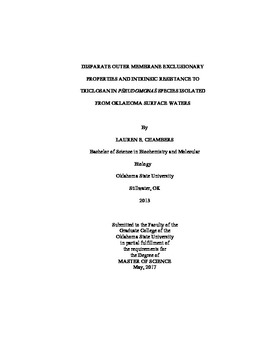| dc.contributor.advisor | Champlin, Franklin R. | |
| dc.contributor.author | Chambers, Lauren E. | |
| dc.date.accessioned | 2018-03-13T18:15:04Z | |
| dc.date.available | 2018-03-13T18:15:04Z | |
| dc.date.issued | 2017-05-01 | |
| dc.identifier.uri | https://hdl.handle.net/11244/54499 | |
| dc.description.abstract | Outer membrane exclusionary properties of Pseudomonas aeruginosa underlie its intrinsic resistance to the hydrophobic biocide triclosan, but environmental bacteria have not been analyzed for similar properties. Bacterial communities were sampled by directly plating surface waters from three locations onto Reasoner's 2A agar (R2A) either lacking or containing triclosan. Two isolates from each plating method were chosen for detailed examination based on their relationships to triclosan and phylogenetic similarities to P. aeruginosa. Macrobroth dilution bioassays and batch cultural growth kinetics were initially employed to assess the degree to which isolates were intrinsically resistant to the mechanistically-disparate hydrophobic molecules novobiocin and triclosan. Minimal inhibitory concentrations (MICs) for novobiocin and triclosan for susceptible organisms were predictably low with the exception of LD7A being resistant to novobiocin. In contrast, MICs for organisms selected for with triclosan were high. Triclosan titrations of batch cultures revealed growth kinetics for isolates obtained in the absence of triclosan were inhibited in a concentration-dependent manner, while growth kinetics were similar to respective controls at all concentrations for resistant isolates selected for with triclosan. These data were confirmed by outer membrane accessibility to the hydrophobic probe 1-N-phenylnapthylamine (NPN) by measuring relative fluorescence of treated isolates. The results revealed susceptible isolate LD8B possessed an exceptionally accessible outer membrane in comparison to LD7A, although both susceptible isolates had outer membranes significantly less accessible to NPN than triclosan-resistant isolates. The degree to which isolates could be sensitized to novobiocin and triclosan in the presence of the outer membrane permeablizer compound 48/80 was also determined using growth kinetics. The triclosan-susceptible isolates were permeable to both novobiocin and triclosan regardless of compound 48/80 concentrations. Triclosan-resistant isolate HD33 was able to resist sensitization to novobiocin and triclosan in the presence of compound 48/80, whereas isolate HD36 was slightly sensitized to both novobiocin and triclosan. These results support the notion that outer membrane exclusion underlies intrinsic resistance to hydrophobic substances in some, but not all Pseudomonas spp. selected for on the basis of triclosan resistance from municipal surface waters and that multiple triclosan resistant mechanisms work in concert in these refractory bacteria. | |
| dc.format | application/pdf | |
| dc.language | en_US | |
| dc.rights | Copyright is held by the author who has granted the Oklahoma State University Library the non-exclusive right to share this material in its institutional repository. Contact Digital Library Services at lib-dls@okstate.edu or 405-744-9161 for the permission policy on the use, reproduction or distribution of this material. | |
| dc.title | Disparate Outer Membrane Exclusionary Properties and Intrinsic Resistance to Triclosan in Pseudomonas Species Isolated from Oklahoma Surface Waters | |
| dc.contributor.committeeMember | Curtis, Kathleen S. | |
| dc.contributor.committeeMember | Katz (Amburn), Diana S. | |
| dc.contributor.committeeMember | Sanny, Charles G. | |
| osu.filename | Chambers_okstate_0664M_15083.pdf | |
| osu.accesstype | Open Access | |
| dc.description.department | Biomedical Sciences | |
| dc.type.genre | Thesis | |
| dc.type.material | text | |
